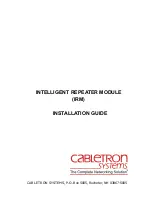
Page 17
APEN GROUP reserves the right to change products and documents as required.
code HG0109.12GB ed.C-1106 rev.12
WARM AIR HEATER SERIES RAPID
CO and NOx values are correct if O
2
=0%.
HG0109_12_ET_007
VALUES MEASURED WITH G20 [Natural gas]
Model
CO
NOx
NOx Class
ppm
ppm
EN1020
RA015
1
42
4
RA024
1
40
4
RA032
1
44
4
RA035
1
41
4
RA043
1
50
4
RA054
1
44
4
5.3
Chimney Piping
RAPID heaters have sealed combustion circuits, and the fan is
installed before the exchanger.
The flue system can have different layouts: type C (combustion
air taken in from outdoor) or type B (combustion air coming
from indoor).
RAPID heaters are certified for the following flue types: C13-
C33-C53-C63-B23.
Use approved pipes and terminals for flue systems.
Intake and flue piping shall avoid the entry of objects having
one dimension larger than or equal to 12 mm.
APEN GROUP certifies its own air intake and flue terminals,
which shall be installed with RAPID heaters.
The standard version of RAPID heaters is equipped with hori-
zontal fittings for connecting the heater to the chimney and to
air intake system. These fittings are on the back of the heater
but they can be moved to the top during installation in order to
ease exhaust from the roof.
Flue piping for non condensing RAPID heaters must be built
using the following materials:
- Aluminum with minimum thickness of 1.0 mm.
- Stainless steel with minimum thickness of 0.4 mm. The carbon
content of the steel must not exceed 0.2%.
Use gasketed tubes to avoid any flue leaks. The gasket must
be suited to flue temperature ranging from 120°C to 220°C
(248°F to 428°F).
Plastic components SHALL NOT be used for building flue
system because flue temperatures are higher than those
allowed by these materials.
Condensate
With flue layouts longer than 8 meters if running indoor, or longer
than 5 meters if running outdoor, condensate may appear in
flue pipes. If so, a condensate manifold (code G15825-08-HV)
should be installed between the heater and the flue system to
collect condensation water.
This kit can be used both on horizontal and on vertical pipes
and should be installed close to the heater.
The manifold shall be connected to the siphon (code G14551)
to prevent the flue from leaking with the condensate.
G14303 kit is also available to treat condensation's acidity.
Condensation can then be disposed of anywhere.
Contact your Apen Group Support Centre for more information.
Combined Flue Systems
An independent flue system is to be preferred, whenever
possible. Since RAPID heater flue systems are pressurized, a
wrongly-sized collective flue would cause problems to the unit.
However, if a combined system is required, it will have to be
carefully designed and sized, so that chimney always works
in depression. This will prevent a unit from venting its flue gas
into another unit.
FLUE SYSTEM - C63 TYPE
For Countries where C63 flue systems are allowed, the following
table shows how to calculate the layout of the system using pipes
available in the market. Available pressure at flue is reported in
the table in the following page.
HG0109_12_ET_005
HG0109_12_ET_006
EQUIPMENT SET FOR G20 [Natural gas]
Model
Flue temp. Content
Flue flow rate
[°C]
CO2
[kg/h]
RA015
190
9,1
26,3
RA024
200
9,1
42,2
RA032
210
9,1
55,1
RA035
210
9,0
61,8
RA043
195
9,2
74,9
RA054
195
9,1
92,4
EQUIPMENT SET FOR G31 [Liquid propane gas]
Model
Flue temp. Content
Flue flow rate
[°C]
CO2
[kg/h]
RA015
190
9,7
24,8
RA024
200
9,7
39,7
RA032
210
9,7
52,3
RA035
210
9,8
57,9
RA043
195
9,7
71,4
RA054
195
9,8
86,2
















































